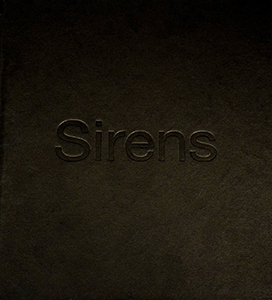Novi_sad, "Sirens"
 Thanasis Kaproulias’ latest release as Novi_sad expands on the compositional strategies found on his last work (2013’s Neuroplanets) but goes a step further both in concept and presentation. The single piece that makes up the audio portion of this multimedia work is first made up of sound provided by other well known sound artists, such as Richard Chartier and Carl Michael von Hausswolff. Not satisfied with that, however, Kaproulias then merges these with decidedly non-musical recordings (bridge vibrations, earthquakes, stethoscopes, etc.), and then further processes them with quantitative data from major financial crises. Decidedly high concept (and accompanied by a hardcover book featuring visualizations of the sound by Ryoichi Kurokawa), Sirens excels on both a conceptual and purely sonic level.
Thanasis Kaproulias’ latest release as Novi_sad expands on the compositional strategies found on his last work (2013’s Neuroplanets) but goes a step further both in concept and presentation. The single piece that makes up the audio portion of this multimedia work is first made up of sound provided by other well known sound artists, such as Richard Chartier and Carl Michael von Hausswolff. Not satisfied with that, however, Kaproulias then merges these with decidedly non-musical recordings (bridge vibrations, earthquakes, stethoscopes, etc.), and then further processes them with quantitative data from major financial crises. Decidedly high concept (and accompanied by a hardcover book featuring visualizations of the sound by Ryoichi Kurokawa), Sirens excels on both a conceptual and purely sonic level.
Even with all of the extrapolation of sound performed by Kaproulias, the artists who supplied the raw material have their own distinct representation as well.The first segment, featuring Richard Chartier, seems to draw on his depressant electronic synth haze of his Pinkcourtesyphone project.His contribution of what sounds like rumbling, deconstructed synth chords may differ greatly from the buzzing electrical surges and low frequency drones provided by Carl Michael von Hausswolff, but the two are effortlessly blended together.
Kaproulias then reforms the sound from Jacob Kirkegaard with recordings of earthquake vibrations into the third movement of Sirens.The low frequency surges capture the quaking land very well, as Kirkegaard’s work is pulled apart into digital interference, churning bass, buzzing insects, and just a general array of bizarre sounds scattered about, sputtering out into a satisfying conclusion. The reworking of Helge Sten’s material takes on a metallic, noisy sheen of frequency modulated synthesizers.Below this surface, Kaproulias builds a sinister sounding, bleak underlayer of sound that eventually subsumes what musicality may have been present into an abyss of darkness and dissonance.
The final portion is perhaps the most surprising.Consisting of solo cello performance by Beckie Foon, the inorganic sounds (recordings from electronic stethoscopes and data from the October 1987 "Black Monday" stock market crash, the treatments are extremely minimal.It sounds as if the additional information was used only to create and modify reverbs or dynamics, resulting in a subtle, yet ghostly tinge that envelopes the entire piece.The result is a surprisingly pure and traditionalist conclusion to an otherwise complex and concept heavy composition.
Besides the excellent sound, visual artist Ryoichi Kurokawa’s work that accompanies the music of Sirens makes for a brilliant co-presentation.He uses the audio data (with timestamps provided in the images) to generate abstract visions, blended with conventional images.The result are striking images of sonic, granular clouds, shaped into images of animals, landscapes, and people that mesh the familiar with the abstract.
Novi_sad’s work has been showing drastic steps in evolution and complexity since his debut just shy of a decade ago.That evolution is a striking one, moving from the more traditional processing and reassembling of prerecorded sounds and samples into a compositional method that applies non-musical and statistical data as an additional element.Even as a piece of music, without any knowledge of its underlying structure, concept, or visual accompaniment, Sirens would be an extremely impressive work.With all of those additional trappings, it becomes all the more magnificent and fascinating when taken as its intended, fully multimedia approach.
samples:
 



